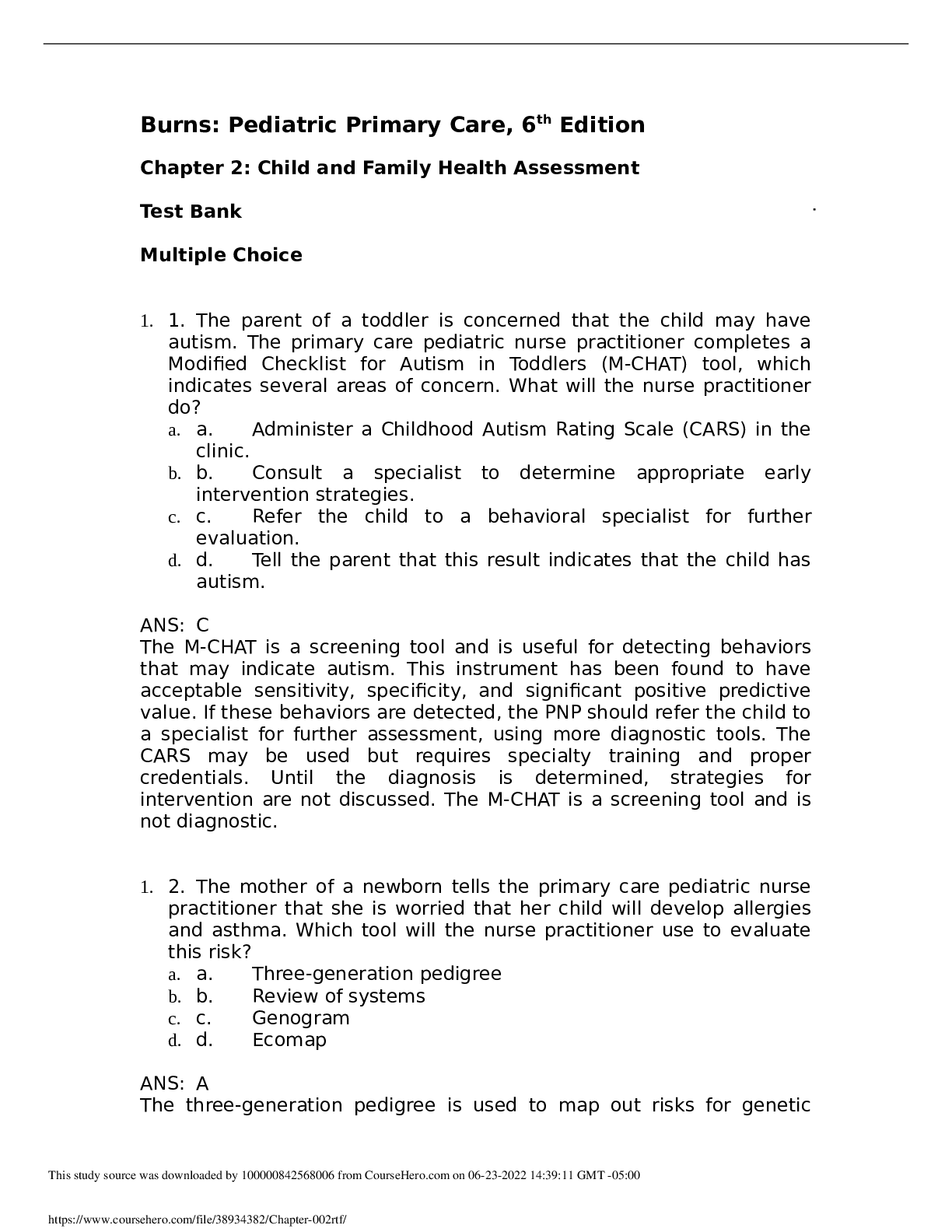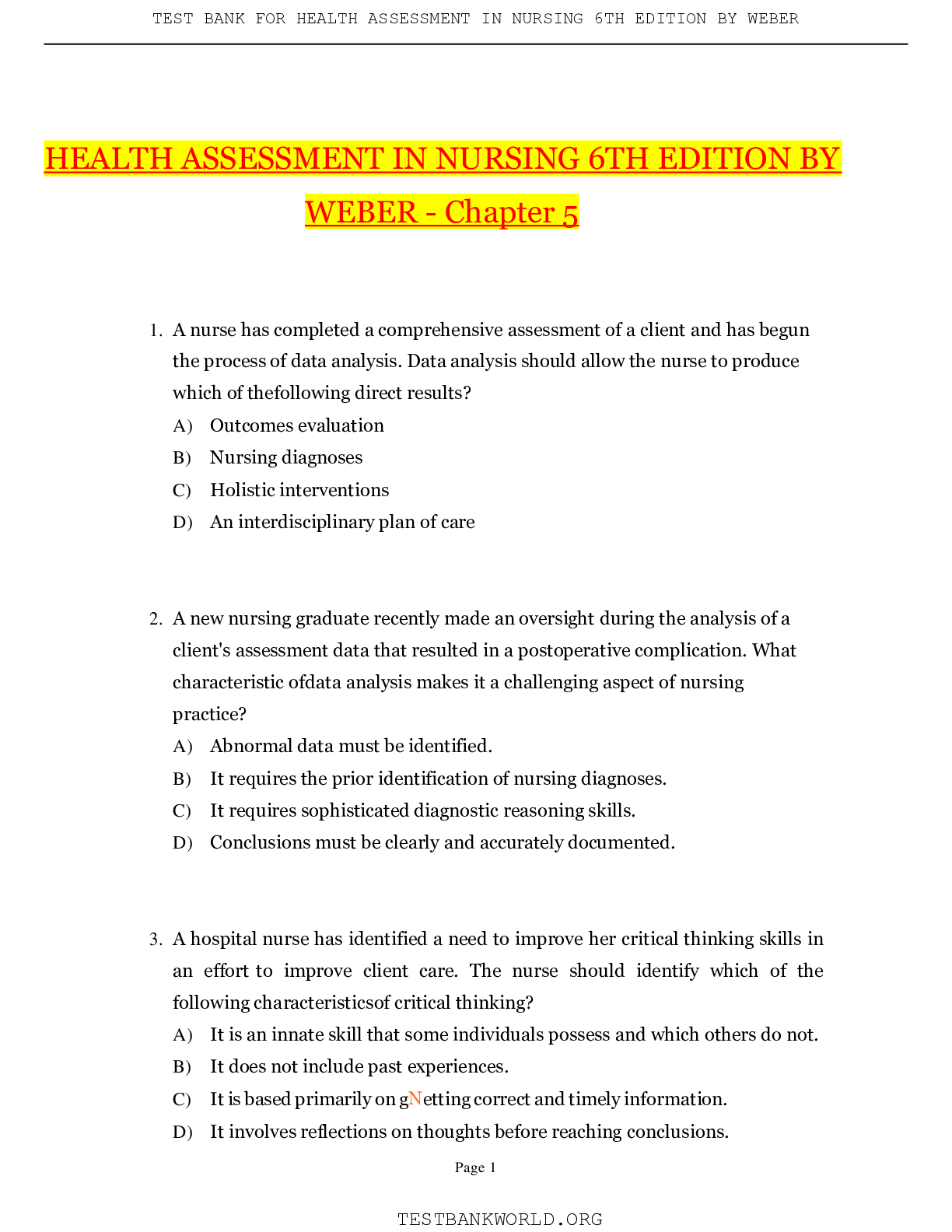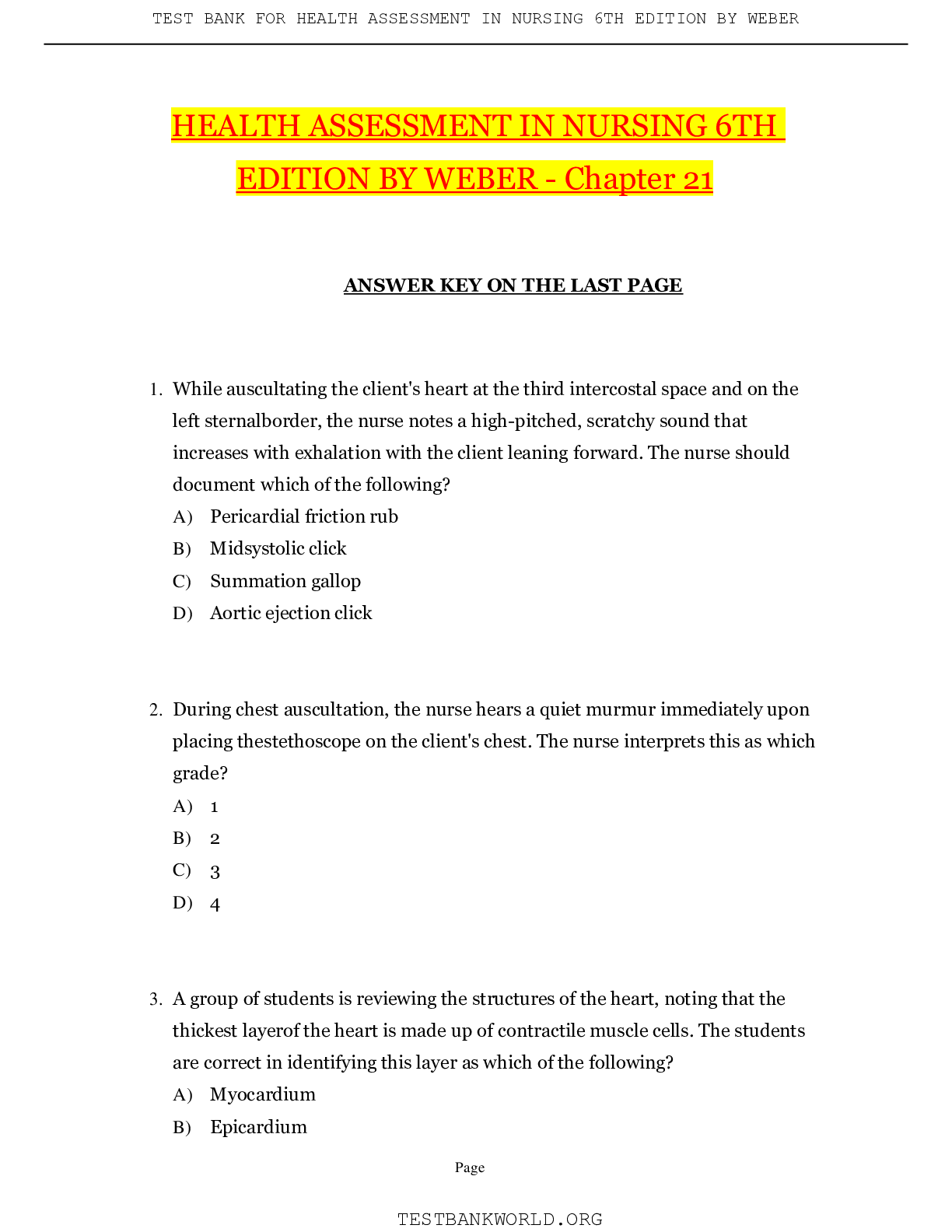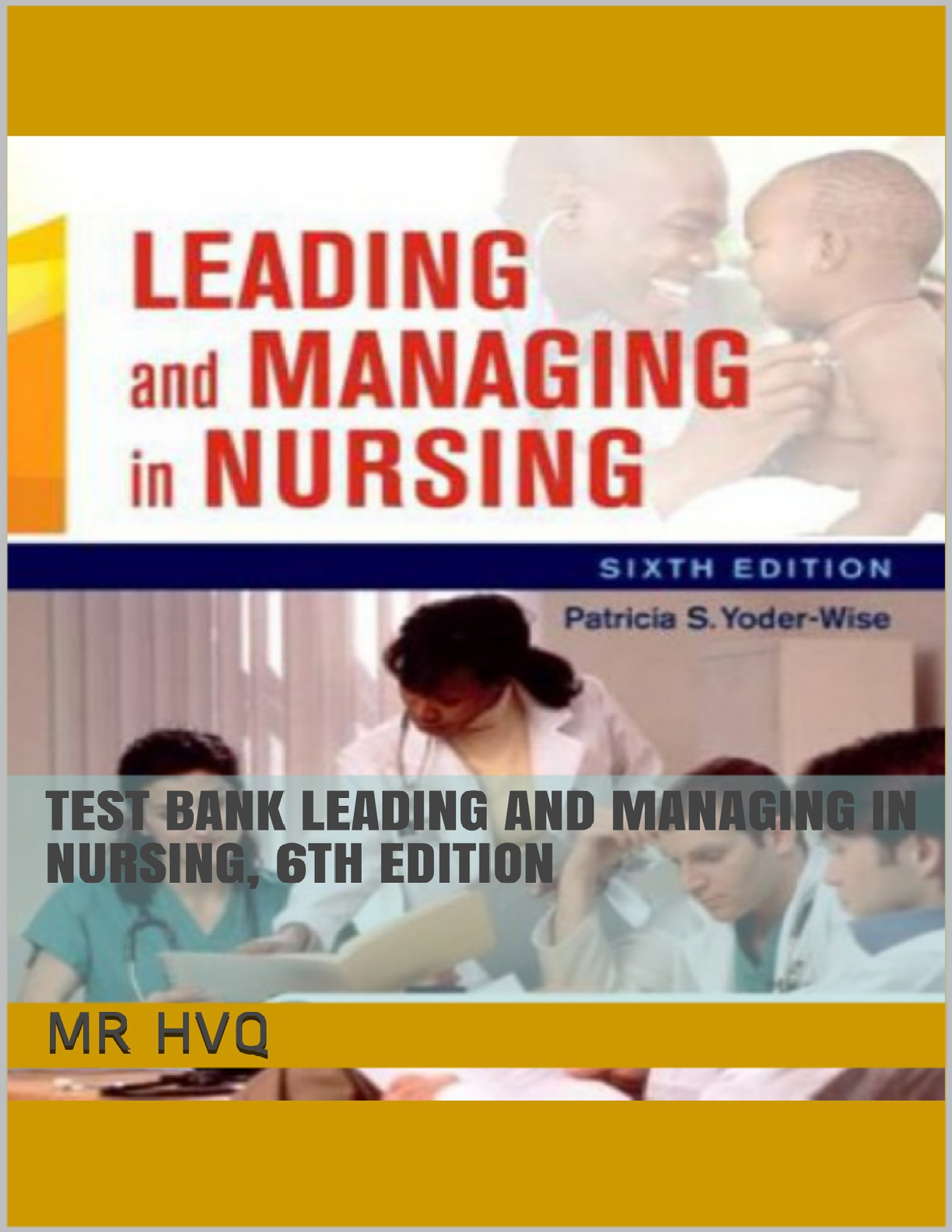Health Care > EXAM > HEALTH ASSESSMENT IN NURSING 6TH {Chapter 32}:32Assessing older adults 100% CORRECT (All)
HEALTH ASSESSMENT IN NURSING 6TH {Chapter 32}:32Assessing older adults 100% CORRECT
Document Content and Description Below
1. The nurse is conducting a functional assessment of an older adult client. The nurse should focus questions on which area? A) Feelings about aging B) Quality of life C) Recent personal losses D)... Activities of daily living 2. A nurse assesses the skin of an older adult's forearms and observes purpura. The nurse interprets this finding as indicative of which of the following? A) Elder abuse B) Vascular fragility C) Poor circulation D) Herpes zoster 3. When examining the skin of an elderly client, the presence of which skin lesions should indicate a need for referral? A) Cherry angioma B) Actinic keratosis C) Seborrheic keratosis D) Acrochordons 4. When examining the eyes of an elderly client, the nurse observes a brownish discoloration of the lens. The nurse interprets this finding as being suggestive of what health problem? A) Conjunctivitis B) Presbyopia C) Glaucoma D) Cataracts 5. During an assessment of an elderly client, the nurse notes a decrease in pupil size and a slowed reaction of the pupil to light. Accommodation and convergence are normal. Based on these findings, which of the following should the nurse emphasize with client education? A) Use drops to prevent dryness B) Wear sunglasses outdoors C) Avoid driving at night D) Obtain an eye examination 6. A nurse is preparing a health education class for a group of older adult clients at a local senior center. The nurse is focusing on health promotion and disease prevention. Which condition would the nurse cite as a common cause of infection-related deaths in the elderly? A) Pyelonephritis B) Cellulitis C) Pneumonia D) Meningitis 7. When auscultating the heart of an elderly client, the nurse detects a soft systolic murmur at the base of the heart. The nurse understands that this is most likely the result of which of the following? A) Calcification of the aortic and mitral valves B) Accumulation of amyloid in the pacemaker cells C) Enlargement of the heart muscle D) Regurgitation through a stenotic valve 8. A client's medical assessment reveals no heart disease. An electrocardiogram is performed and a dysrhythmia is noted. The nurse interprets this finding as most likely reflecting which of the following age-related changes? A) Decreased ventricular compliance B) Peripheral vascular disease C) Widening pulse pressure D) Collagen deposits around pacemaker cells 9. A nurse assesses a client's blood pressure and the findings suggest orthostatic hypotension. Which area should the nurse emphasize during client education? A) Daily exercise routine B) Prevention of falls C) Diet high in iron D) Vitamin supplementation 10. The children of an elderly client tell the nurse, ìHe has lost his appetite. He eats very small amounts, and only twice a day.î Which suggestion would be most appropriate? A) Inform them that he will eat when he is hungry. B) Counsel them to weigh him daily. C) Recommend nutrient-dense foods. D) Advise them to restrict fluid intake. 11. The nurse is assessing an elderly client who is receiving tube feedings via a nasogastric tube. The nurse should assess the client for signs and symptoms of which of the following? A) Gingivitis B) Sinusitis C) Epiglottitis D) Cellulitis 12. The advanced practice nurse is preparing to perform a pelvic examination on an elderly female client. Which of the following would the nurse expect to find? A) Elongation of the vagina B) Thick, pale epithelium C) Decreased vaginal secretions D) Palpable ovaries 13. When assessing an elderly client's hip joint after a fall, which of the following should lead the nurse to suspect that the client has a hip fracture? A) Internal rotation of the affected leg B) Abduction of the affected leg C) Partial weight bearing D) Thigh pain 14. After teaching a group of students about geriatric syndromes, the instructor determines that the teaching was successful when the students identify which of the following as an example? A) Confusion B) Pneumonia C) Heart failure D) Renal failure 15. A nurse has assessed an elderly client and is preparing to analyze the assessment data. Which of the following would the nurse need in order to accurately perform data comparison? A) Client's major complaints B) Client's usual daily patterns C) Client's adherence to treatment D) Client's underlying pathology 16. A home care nurse is assessing an older adult's functional status. The nurse should identify which of the following as an instrumental activity of daily living? A) Bathing B) Cooking C) Toileting D) Eating 17. A nurse is interviewing an elderly client and begins the interview by evaluating the client's mental status. The nurse does this based on an understanding of which of the following? A) The aging brain is more easily affected by pathology. B) Older clients have decreased intellectual capacity. C) The brain is the last organ to experience an age-related decline. D) The client is always the most reliable person to provide the data. 18. An elderly client's history reveals the use of antihistamines. When inspecting the client's mouth, which of the following would the nurse expect to find? A) Resorption of the gum ridge B) Swollen, red tongue C) Decreased saliva production D) Pocketing of food 19. An elderly client with a history of sinusitis has been taking antibiotics for this condition. The nurse should assess for what potential adverse effect of treatment? A) Exacerbation of cardiac dysrhythmias B) Candidal infection C) Overdrying of nasal passages D) Exacerbation of hypertension 20. The nurse has assessed the thorax and lungs of an elderly client, as well as reviewing the results of lung function testing. Which of the following findings should the nurse attribute to possible pathology rather than expected, age-related changes? A) Respiratory rate of 30 breaths per minute B) Decreased vital capacity C) Increased residual volume D) Presence of a slight barrel chest 21. The nurse is interviewing an 82-year-old client who is accompanied by her daughter. The daughter states that her mother is ìunable to hold her urine,î and the client attests that this is true. What question should the nurse prioritize when assessing the client's urinary incontinence? A) ìDid you deliver your children vaginally or by cesarean section?î B) ìHave you been prone to urinary tract infections in the past?î C) ìIs this something that has begun to happen just recently?î D) ìHave you noticed any change in your bowel function?î 22. An older adult client has been admitted to the intensive care unit after experiencing a serious decline in health due to influenza. The client's family is surprised that influenza could have such serious health consequences. When educating the family about this phenomenon, what should the nurse describe? A) Older adults' immune systems cannot produce new antibodies. B) Older adults have a diminished physiologic reserve. C) Older adults lack resistance to many common viruses. D) Older adults cannot tolerate antibiotics used to treat influenza. 23. The gerontologic nurse is using the SPICES screening tool to assess an older adult's health status. The nurse will assess for which of the following health problems? Select all that apply. A) Sleep disturbances B) Infection C) Poor nutrition D) Falls E) Pain 24. A nurse is using the Katz Activities of Daily Living tool to assess an older adult's functional status. What question will the nurse include in this assessment? A) ìWho generally prepares your meals and snacks?î B) ìDo you require any assistance when showering or bathing?î C) ìDo you feel like you have enough support from your family?î D) ìAre you able to shop for your own groceries?î 25. The nurse is assessing an older adult client's vaccination history. This aspect of the client's history will have a significant bearing on her risk for what health problem? A) Pneumonia B) Urinary tract infections C) Cellulitis D) Tuberculosis 26. An older adult client who enjoys good overall health has sought care because of a recent onset of weakness and fatigue. The client is unaware of any precipitating events. How should the nurse proceed with assessment? A) Perform a focused respiratory assessment. B) Obtain the client's vaccination history. C) Assess the client for signs and symptoms of anemia. D) Assess the client for evidence of chronic heart failure. 27. An older adult client has received a diagnosis of stress incontinence, and the nurse is planning the client's subsequent care. What health education is most relevant to this client's needs? A) Pelvic floor strength training and activity management B) Appropriate use of incontinence pads and dietary modifications C) Management of fluid and electrolyte intake D) Aseptic technique for intermittent catheterization and fluid restriction 28. The nurse is reviewing an older adult's recent laboratory values prior to performing a physical assessment. What value would most clearly indicate the need for further nutritional assessment? A) Hemoglobin 12.2 g/dL B) Hematocrit 40% C) Serum albumin 3.9 g/dL D) Vitamin B12 91 g/ml 29. An older adult client has come to the clinic with new complaints of fatigue, constipation, and cold intolerance. This client may benefit from referral for which of the following purposes? A) Liver function testing B) Cognitive testing C) Lung function testing D) Assessment of thyroid function 30. An older adult client has been admitted for assessment related to decreased cognition. What assessment finding is most suggestive of delirium as the cause of the client's cognitive changes? A) The client has a family history of cognitive disorders. B) The client recently began a new medication regimen. C) The client has been under significant psychosocial stress. D) The client's cognition has declined over several months. [Show More]
Last updated: 1 year ago
Preview 1 out of 7 pages
Instant download
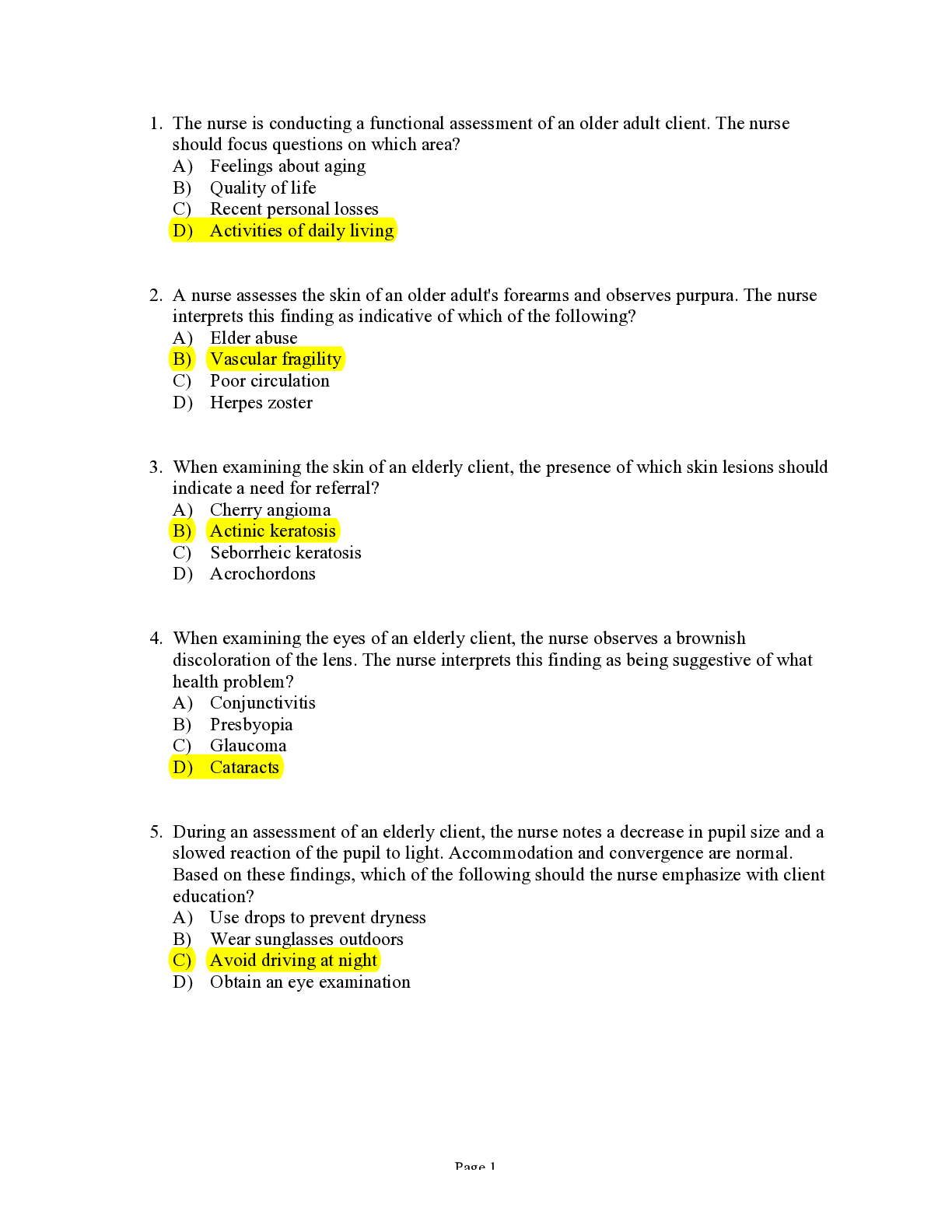
Buy this document to get the full access instantly
Instant Download Access after purchase
Add to cartInstant download
Reviews( 0 )
Document information
Connected school, study & course
About the document
Uploaded On
Mar 29, 2021
Number of pages
7
Written in
Additional information
This document has been written for:
Uploaded
Mar 29, 2021
Downloads
0
Views
60




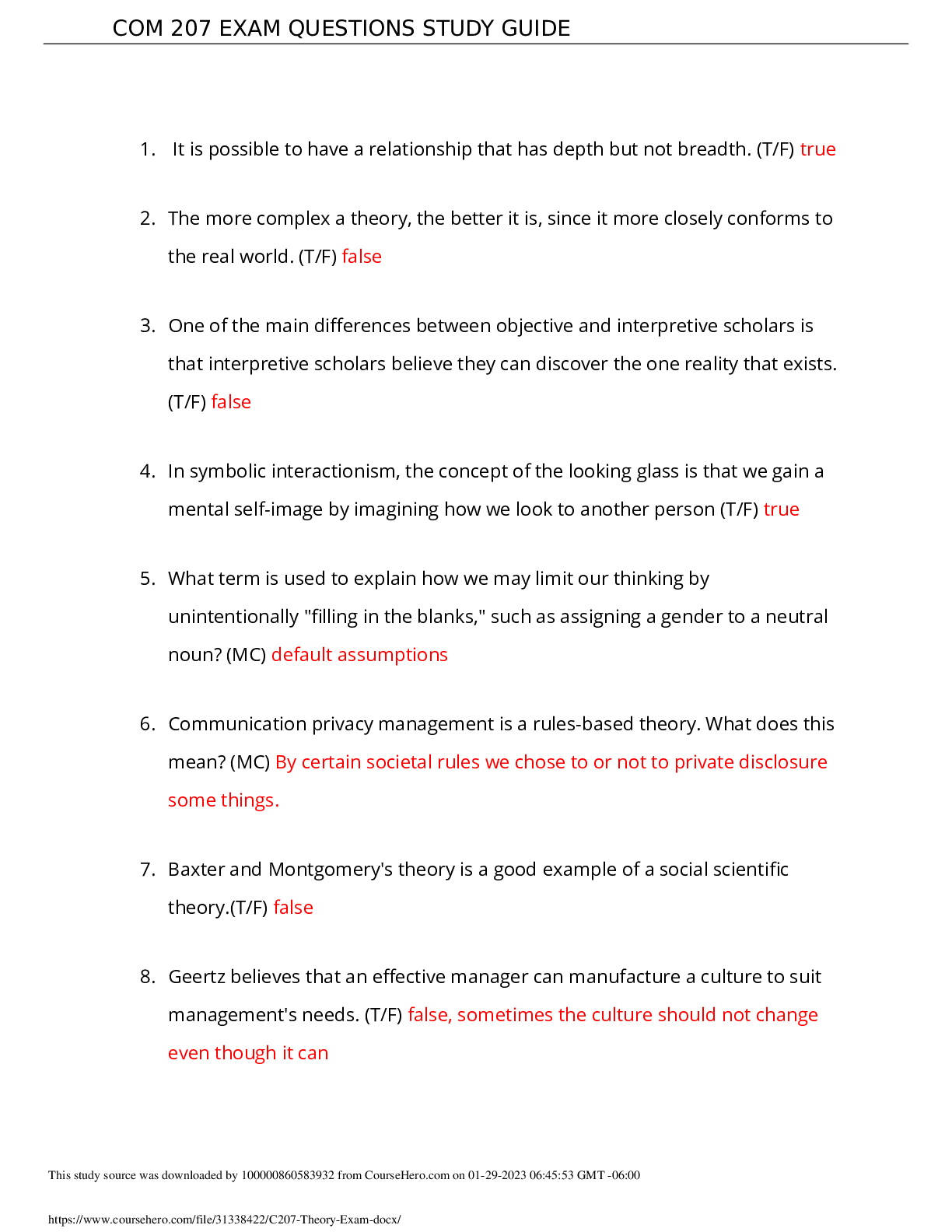
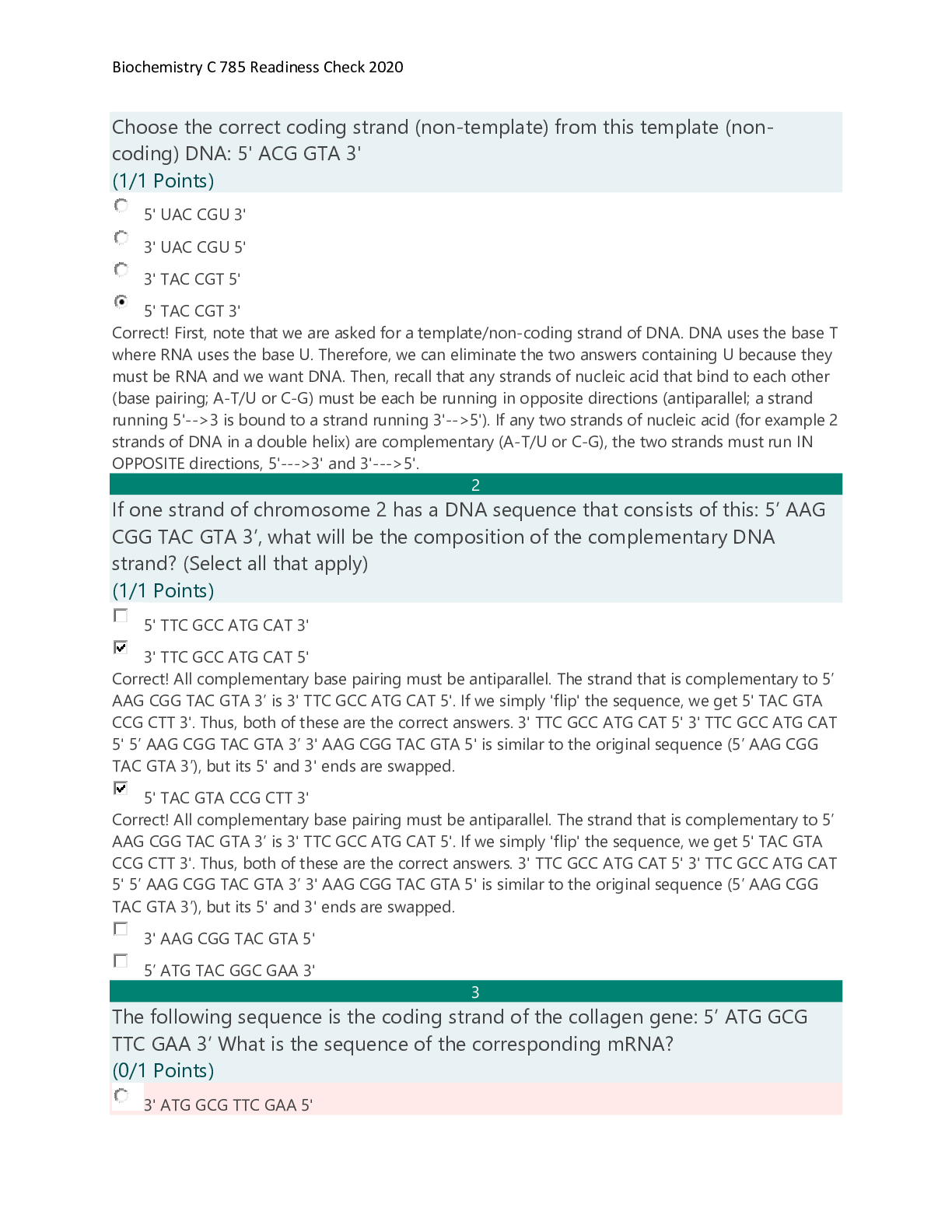
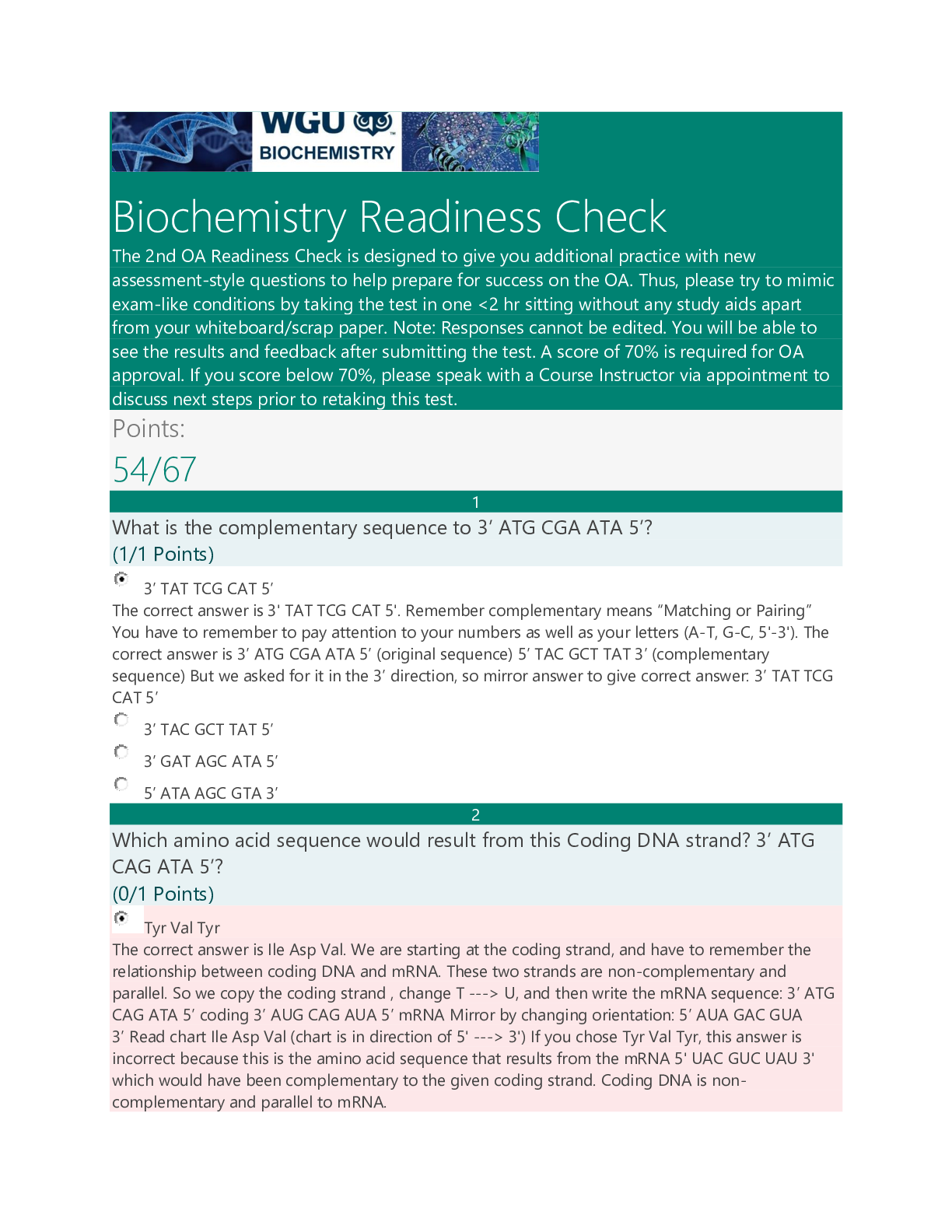


.png)

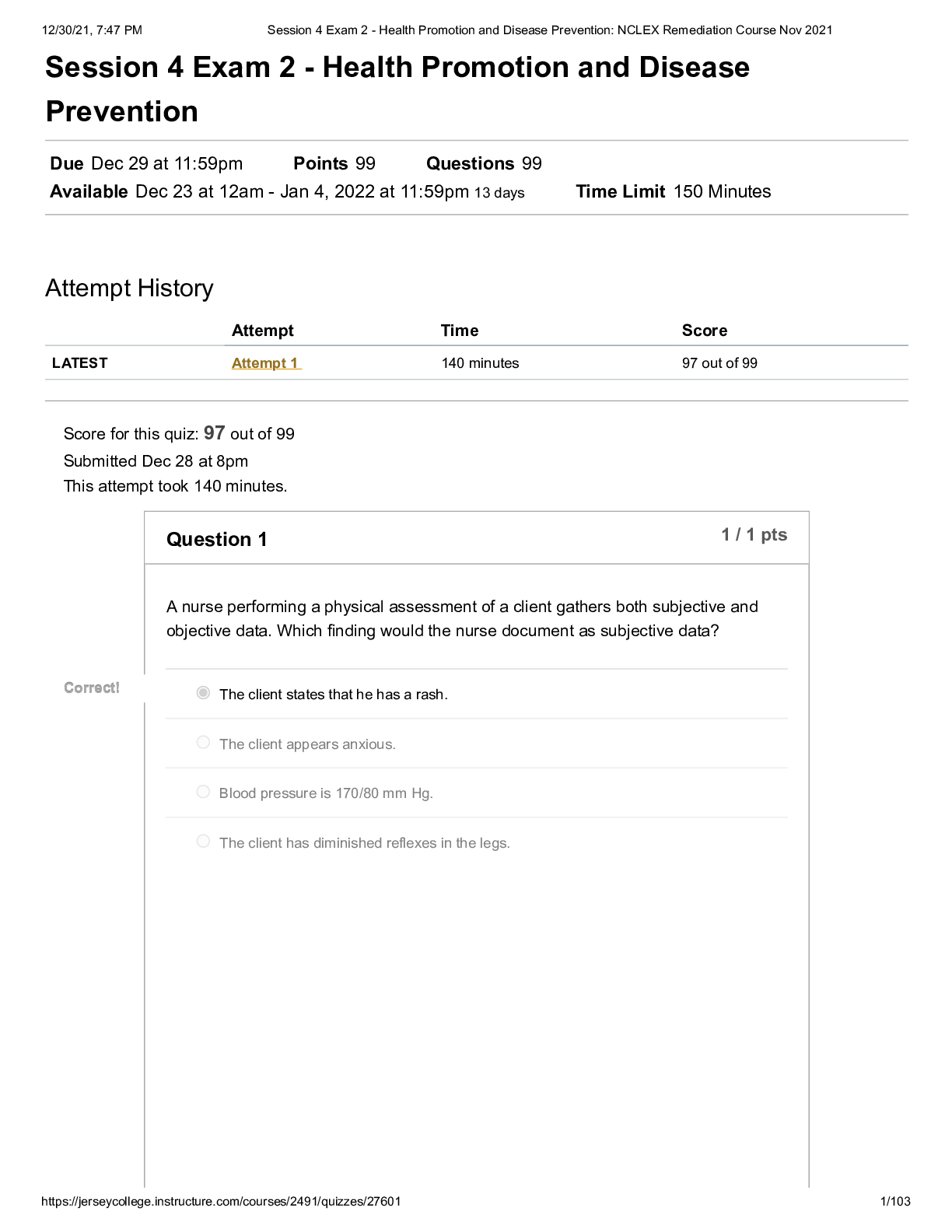
 ORGMED ORGANIC PHARMACEUTICAL PHARMACY.png)
